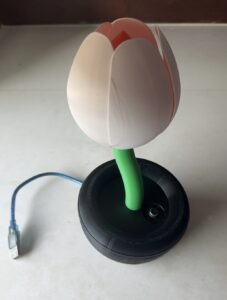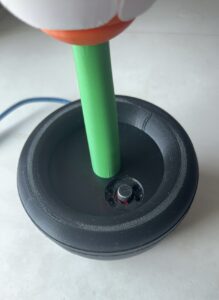Concept:
The idea of this project is to use art and technology to make a flower come alive. It’s about creating a flower that moves, reacts to sound, and interacts with people through mouse movements. Instead of being just a simple object, the flower feels lifelike and connected to its surroundings.
This is done using an Arduino Nano, sensors, and p5.js. The flower sways like it’s in the wind, reacts to sounds, and changes based on where you move your mouse. The project shows how we can use technology to make everyday objects interactive and bring them to life in creative ways.
Setting up the Flower:
Setting up the flower was simple but really exciting. I started by 3D printing the parts. The petals are white with a hint of orange inside, which gives them a soft, natural look. The stem is bright green, making it feel like a real flower, and the base is black to keep everything stable and balanced.
Inside the base, I will add all the electronics. I will use an Arduino Nano, a microphone sensor, and an RGB LED. The microphone will listen to sounds, like clapping or blowing, and the flower will react by swaying more when it detects them. I will carefully hide all the wires and parts inside the base, so from the outside, it will still look clean and simple—just like a real flower.


Arduino Code:
The Arduino code will handle the hardware interactions, making the flower responsive to its environment. It will be uploaded to an Arduino Nano and will collect data from the microphone sensor. This sensor will detect sounds like clapping or blowing and send the data to the p5.js program. The Arduino will also control the RGB LED at the base of the flower, allowing it to change colors in response to user interactions.
The microphone readings will be processed and sent over a serial connection to the computer. This data will allow the p5.js code to adjust the flower’s sway based on the intensity of the sounds. The Arduino code will ensure smooth communication between the hardware and the software, acting as the bridge that connects physical inputs to the digital flower.
p5.js Code:
The p5.js code will bring the visual and interactive elements of the flower to life. It will process the data received from the Arduino and use it to control the flower’s movements and reactions. For example, when louder sounds are detected, the code will make the flower sway more dramatically, as if pushed by strong wind.
The petals will respond to mouse movements, with their size changing when the mouse moves up or down, and the RGB LED’s color changing as the mouse moves left or right. Perlin noise will be used to create smooth and natural-looking swaying motions for the flower and its leaves. The background will display a gradient that blends soft colors, like a sunset, to set a peaceful scene.
The p5.js code will integrate all these elements, creating a system where the flower not only looks alive but also reacts and interacts in real time. Together with the Arduino code, it will make the flower feel connected to its environment and user inputs.
